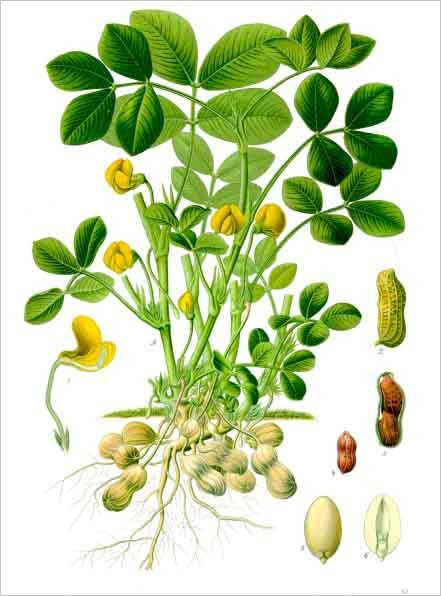Peanuts

Peanuts are native to South America. The ancient Incas of Peru stashed peanuts in jars at burial sites to nourish departed spirits. Peanuts made their way to the southern colonies of North America with slaves from West Africa, who planted them as a food crop to feed themselves. They called the nut "nguba," which was the origin of the word "goober," one of many names for the peanut.
Peanuts are not really nuts. Nuts grow on trees. The peanut plant is a vine. Peanuts are legumes, related to beans and peas. Legumes help restore poor soils by capturing nitrogen from the air and making it available to the plants through their root systems.
Peanuts grow underground. The peanut is the fruit of the plant. The peanut seed grows into a small green bush, about 18 inches tall. It has delicate yellow flowers. After the flower loses its petals, the flower stalk, or peg, is pulled by gravity toward the ground. The peg grows into the ground and forms peanuts about one inch below the soil surface. It takes about four to five months for the peanut plant to grow from planting to harvest.
To harvest a peanut plant, the farmer cuts the main taproot and pulls the plant gently from the soil. The plants are left in the field for a few days to dry. Then the peanut pods are taken from the plant with a machine called a "combine."
Peanuts need a long growing season to produce mature seeds. They will not tolerate frost. Although they form underground, the edible portions of the plant are not tubers but seeds housed in a capsule—a nutlike shell.
The peanut is about 28 percent protein, 50 percent oil, 18 percent carbohydrates, and 4 percent ash. They are rich in Vitamin B complex (for strong muscles and tissues). They can be used in soup, salads, puddings and breads. In the US, one-fourth of all edible peanuts end up in candy bars, and over half are used for making peanut butter. The average American eats about 11 pounds of peanuts a year, enough to make over 10 billion peanut butter sandwiches. Worldwide, about two-thirds of the peanut crop is crushed for oil. Peanut oil supplies about 8 percent of the world's edible oil production. Peanut products are used in food processing and for animal food. The peanut shell and residues left after oil pressing can be fed to animals. Plants can also be left in the ground to provide excellent forage for cattle and swine and to help enrich the soil.
The peanut is now cultivated in more than 40 countries on six continents. India and China produce more than half the peanuts in the world, followed by Nigeria, Senegal, the US, Indonesia, Sudan, and Burma. In the US, the major peanut-growing states are Georgia, Alabama, North Carolina, and Texas. Oklahoma ranks ninth among the states that raise peanuts in our country.
Peanut Butter
Americans buy over 800 million pounds of peanut butter each year—enough to coat the floor of the Grand Canyon. At graduation, the average high school student will have consumed 1,500 peanut butter and jelly sandwiches. Our enthusiasm for the sticky substance isn't shared by the rest of the world, however. Very little peanut butter is consumed outside the United States.
The standard recipe for manufactured peanut butter calls for 90 percent peanuts, 10 percent salt, natural sweeteners and some kind of vegetable oil. Peanut butter was invented around 1890 by a St. Louis doctor who was looking for a nutritious, inexpensive food for elderly people to eat. It wasn't coupled with jelly until the 1920s. After that, people began adding all kinds of things to peanut butter and jelly sandwiches. Some additions include bacon, bananas, chocolate chips, pickles, raisins and raw onions.
Peanut butter slices, wrapped individually like American cheese, are now available in many grocery stores. These are an Oklahoma invention, developed at Oklahoma State University's Food and Technology Center.
Learning Activities
- Smart Board Activity: Peanut Verbs
(Need help?)Please be patient with us as we learn how to use this new technology.
You must have Smart Notebook software installed on your computer to open Smart Board activities. If you have Smart Notebook software and are using Internet Explorer, you may get a message telling you the activity cannot be opened. In this event, save the activity to your hard drive. Your browser will save it as a zip file. Simply change the "zip" in the file name to "notebook," and you should be able to open it.
Thank you for your patience.
Smart Board Acitivity page
- Smart Board Activity: Peanut Estimation
(Need help?)Please be patient with us as we learn how to use this new technology.
You must have Smart Notebook software installed on your computer to open Smart Board activities. If you have Smart Notebook software and are using Internet Explorer, you may get a message telling you the activity cannot be opened. In this event, save the activity to your hard drive. Your browser will save it as a zip file. Simply change the "zip" in the file name to "notebook," and you should be able to open it.
Thank you for your patience.
Smart Board Acitivity page
Additional Resources
 Arachis Hypogaea (Peanut Plant), Franz Eugen Köhler, Köhler's Medizinal-Pflanzen
Arachis Hypogaea (Peanut Plant), Franz Eugen Köhler, Köhler's Medizinal-Pflanzen
